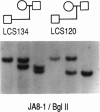Abstract
One-half of all cases of Wilms tumor (WT), a childhood kidney tumor, show loss of heterozygosity at chromosomal band 11p13 loci, suggesting that mutation of one allele and subsequent mutation or loss of the homologous allele are important events in the development of these tumors. The previously reported nonrandom loss of maternal alleles in these tumors implied that the primary mutation occurred on the paternally derived chromosome and that it was "unmasked" by loss of the normal maternal allele. This, in turn, suggests that the paternally derived allele is more mutable than the maternal one. To investigate whether germinal mutations are seen with equal frequency in maternally versus paternally inherited chromosomes, we determined the parental origin of the de novo germinal 11p13 deletions in eight children by typing lymphocyte DNA from these children and from their parents for 11p13 RFLPs. In seven of the eight cases, the de novo deletion was of paternal origin. The one case of maternal origin was unremarkable in terms of the size or extent of the 11p13 deletion, and the child did develop WT. Transmission of 11p13 deletions by both maternal and paternal carriers of balanced translocations has been reported, although maternal inheritance predominates. These data, in addition to the general preponderance of paternally derived, de novo mutations at other loci, suggest that the increased frequency of paternal deletions we observed is due to an increased germinal mutation rate in males.
Full text
PDF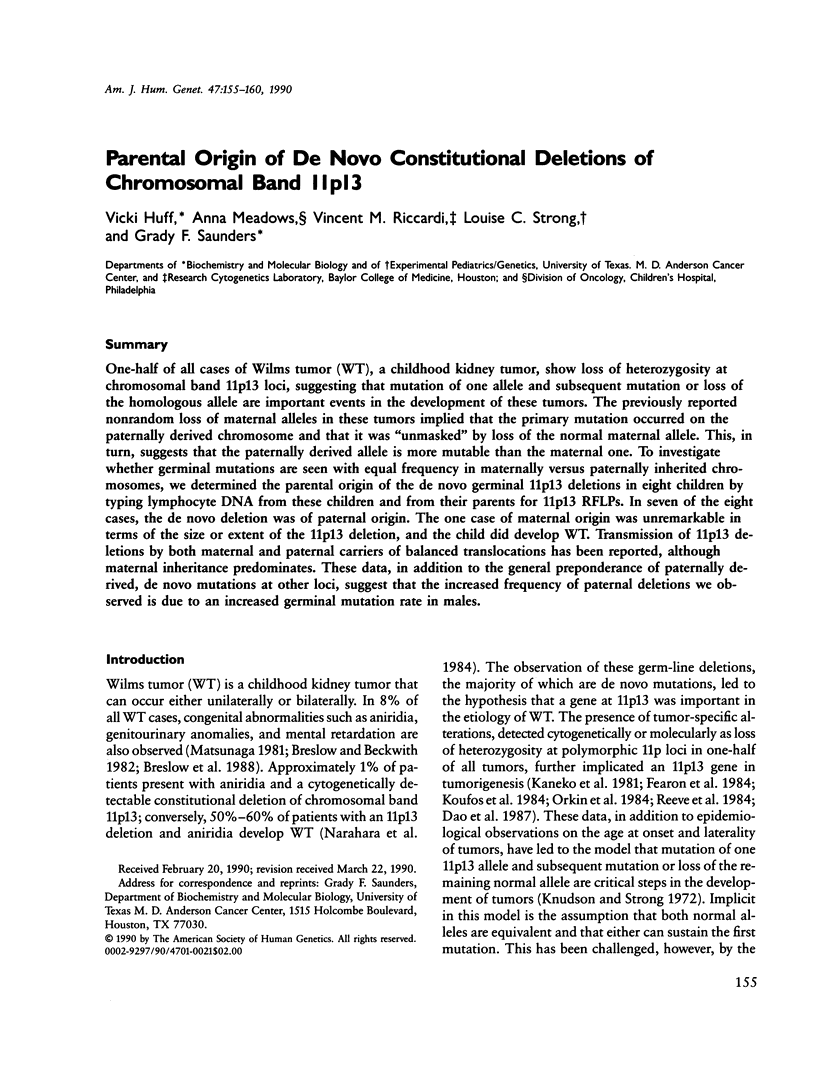
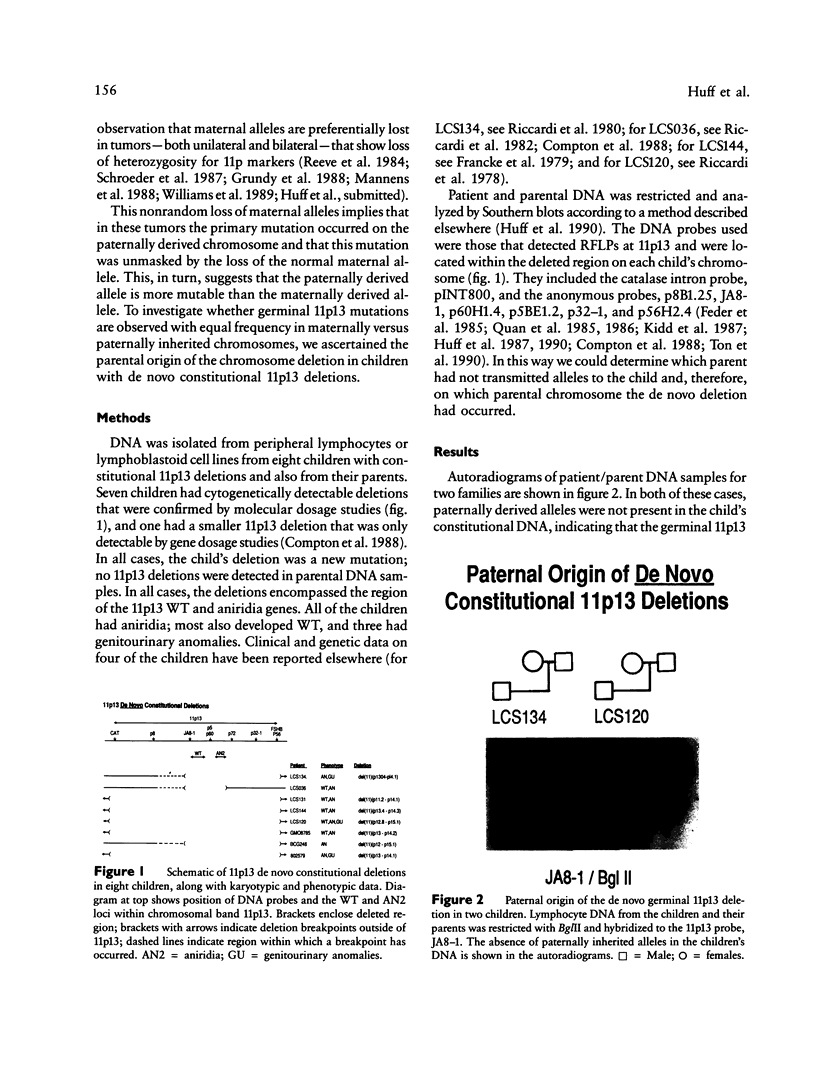
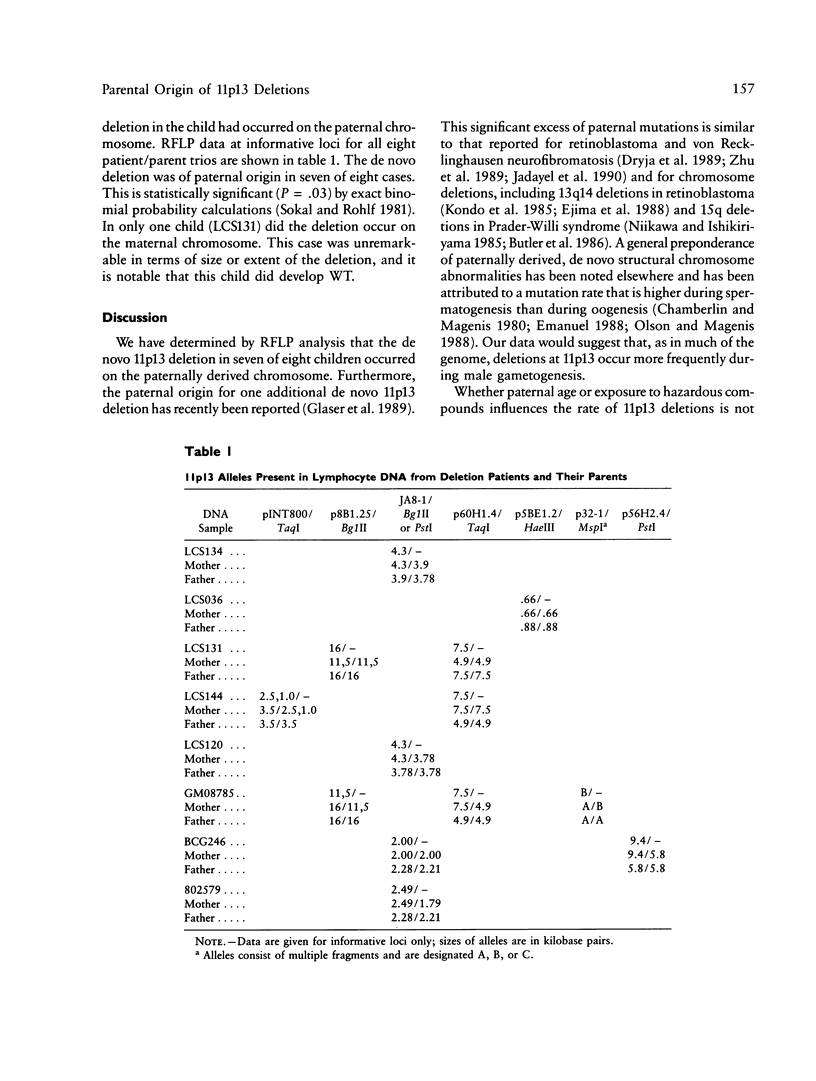
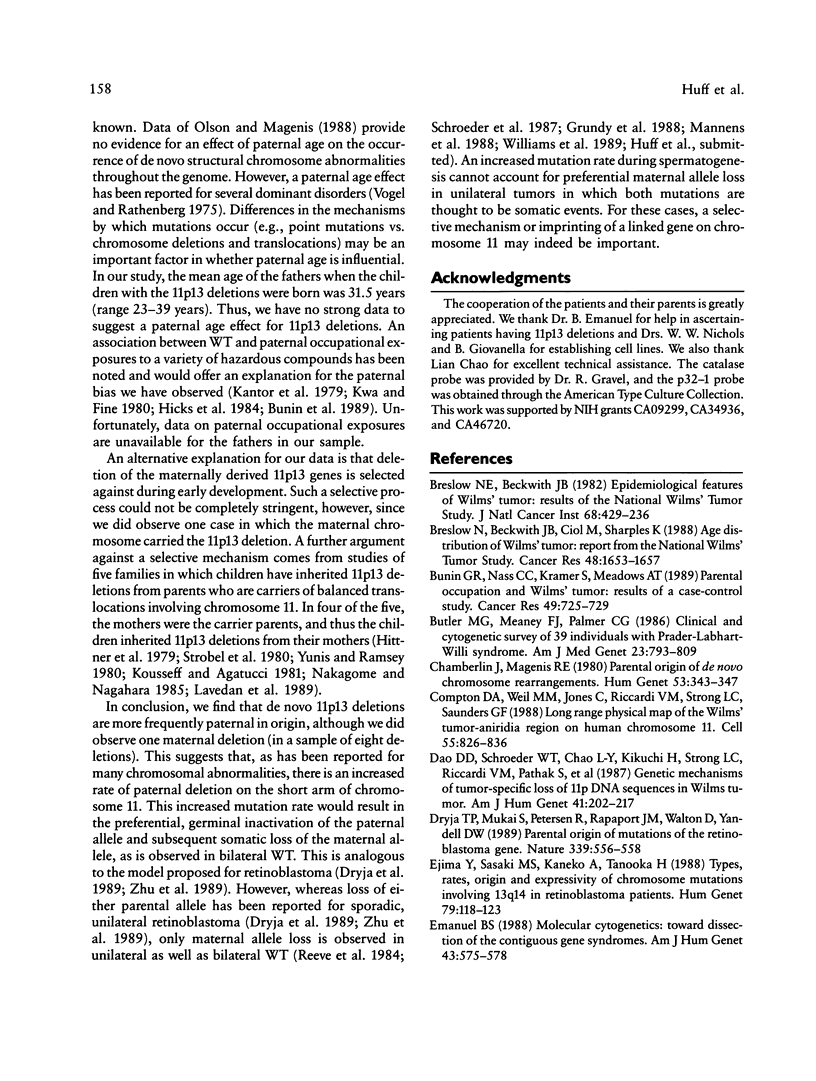
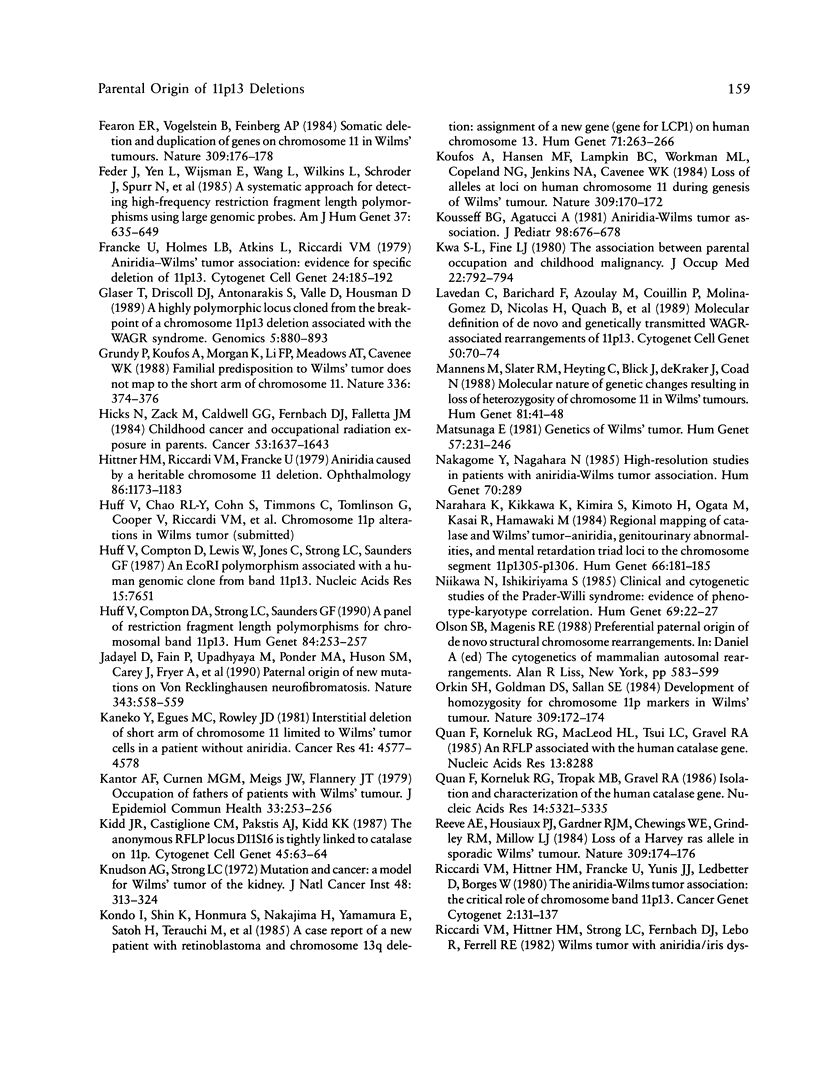
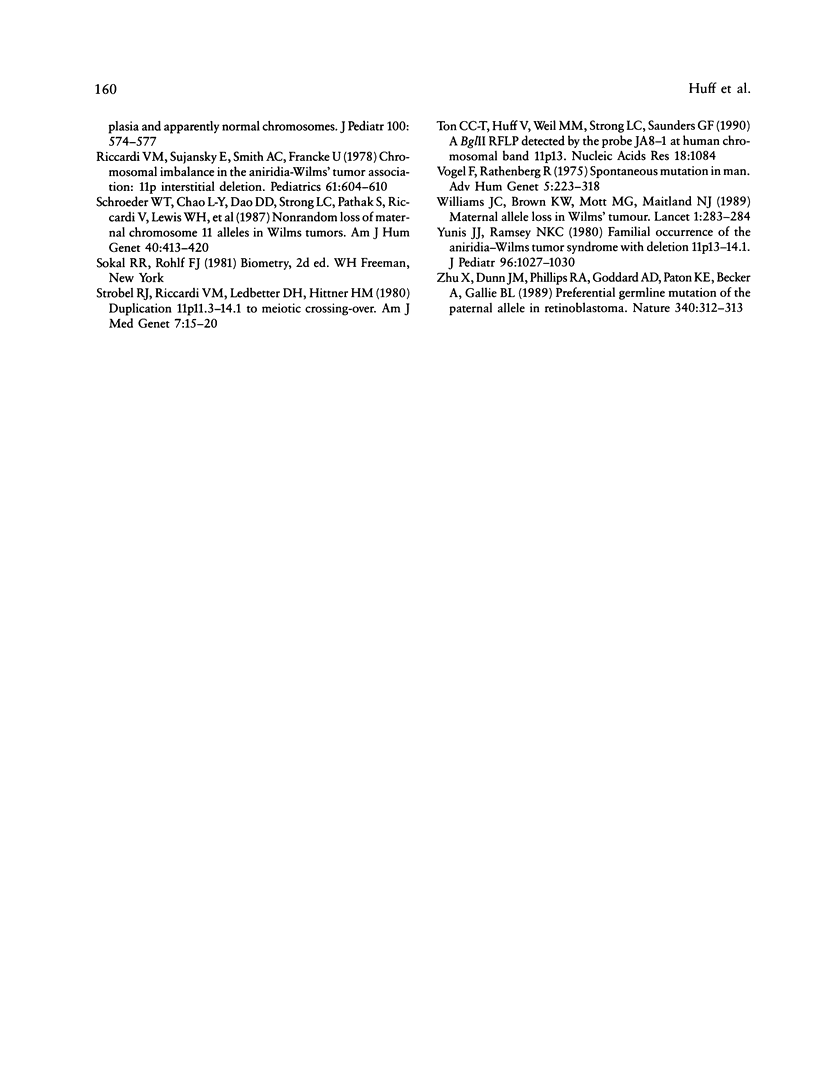
Images in this article
Selected References
These references are in PubMed. This may not be the complete list of references from this article.
- Breslow N. E., Beckwith J. B. Epidemiological features of Wilms' tumor: results of the National Wilms' Tumor Study. J Natl Cancer Inst. 1982 Mar;68(3):429–436. [PubMed] [Google Scholar]
- Breslow N., Beckwith J. B., Ciol M., Sharples K. Age distribution of Wilms' tumor: report from the National Wilms' Tumor Study. Cancer Res. 1988 Mar 15;48(6):1653–1657. [PubMed] [Google Scholar]
- Bunin G. R., Nass C. C., Kramer S., Meadows A. T. Parental occupation and Wilms' tumor: results of a case-control study. Cancer Res. 1989 Feb 1;49(3):725–729. [PubMed] [Google Scholar]
- Butler M. G., Meaney F. J., Palmer C. G. Clinical and cytogenetic survey of 39 individuals with Prader-Labhart-Willi syndrome. Am J Med Genet. 1986 Mar;23(3):793–809. doi: 10.1002/ajmg.1320230307. [DOI] [PMC free article] [PubMed] [Google Scholar]
- Chamberlin J., Magenis R. E. Parental origin of de novo chromosome rearrangements. Hum Genet. 1980;53(3):343–347. doi: 10.1007/BF00287054. [DOI] [PubMed] [Google Scholar]
- Compton D. A., Weil M. M., Jones C., Riccardi V. M., Strong L. C., Saunders G. F. Long range physical map of the Wilms' tumor-aniridia region on human chromosome 11. Cell. 1988 Dec 2;55(5):827–836. doi: 10.1016/0092-8674(88)90138-9. [DOI] [PubMed] [Google Scholar]
- Dao D. D., Schroeder W. T., Chao L. Y., Kikuchi H., Strong L. C., Riccardi V. M., Pathak S., Nichols W. W., Lewis W. H., Saunders G. F. Genetic mechanisms of tumor-specific loss of 11p DNA sequences in Wilms tumor. Am J Hum Genet. 1987 Aug;41(2):202–217. [PMC free article] [PubMed] [Google Scholar]
- Dryja T. P., Mukai S., Petersen R., Rapaport J. M., Walton D., Yandell D. W. Parental origin of mutations of the retinoblastoma gene. Nature. 1989 Jun 15;339(6225):556–558. doi: 10.1038/339556a0. [DOI] [PubMed] [Google Scholar]
- Ejima Y., Sasaki M. S., Kaneko A., Tanooka H. Types, rates, origin and expressivity of chromosome mutations involving 13q14 in retinoblastoma patients. Hum Genet. 1988 Jun;79(2):118–123. doi: 10.1007/BF00280548. [DOI] [PubMed] [Google Scholar]
- Emanuel B. S. Molecular cytogenetics: toward dissection of the contiguous gene syndromes. Am J Hum Genet. 1988 Nov;43(5):575–578. [PMC free article] [PubMed] [Google Scholar]
- Fearon E. R., Vogelstein B., Feinberg A. P. Somatic deletion and duplication of genes on chromosome 11 in Wilms' tumours. Nature. 1984 May 10;309(5964):176–178. doi: 10.1038/309176a0. [DOI] [PubMed] [Google Scholar]
- Feder J., Yen L., Wijsman E., Wang L., Wilkins L., Schroder J., Spurr N., Cann H., Blumenberg M., Cavalli-Sforza L. L. A systematic approach for detecting high-frequency restriction fragment length polymorphisms using large genomic probes. Am J Hum Genet. 1985 Jul;37(4):635–649. [PMC free article] [PubMed] [Google Scholar]
- Francke U., Holmes L. B., Atkins L., Riccardi V. M. Aniridia-Wilms' tumor association: evidence for specific deletion of 11p13. Cytogenet Cell Genet. 1979;24(3):185–192. doi: 10.1159/000131375. [DOI] [PubMed] [Google Scholar]
- Glaser T., Driscoll D. J., Antonarakis S., Valle D., Housman D. A highly polymorphic locus cloned from the breakpoint of a chromosome 11p13 deletion associated with the WAGR syndrome. Genomics. 1989 Nov;5(4):880–893. doi: 10.1016/0888-7543(89)90130-4. [DOI] [PubMed] [Google Scholar]
- Grundy P., Koufos A., Morgan K., Li F. P., Meadows A. T., Cavenee W. K. Familial predisposition to Wilms' tumour does not map to the short arm of chromosome 11. Nature. 1988 Nov 24;336(6197):374–376. doi: 10.1038/336374a0. [DOI] [PubMed] [Google Scholar]
- Hicks N., Zack M., Caldwell G. G., Fernbach D. J., Falletta J. M. Childhood cancer and occupational radiation exposure in parents. Cancer. 1984 Apr 15;53(8):1637–1643. doi: 10.1002/1097-0142(19840415)53:8<1637::aid-cncr2820530802>3.0.co;2-y. [DOI] [PubMed] [Google Scholar]
- Hittner H. M., Riccardi V. M., Francke U. Aniridia caused by a heritable chromosome 11 deletion. Ophthalmology. 1979 Jun;86(6):1173–1183. doi: 10.1016/s0161-6420(79)35425-2. [DOI] [PubMed] [Google Scholar]
- Huff V., Compton D. A., Strong L. C., Saunders G. F. A panel of restriction fragment length polymorphisms for chromosomal band 11p13. Hum Genet. 1990 Feb;84(3):253–257. doi: 10.1007/BF00200570. [DOI] [PubMed] [Google Scholar]
- Huff V., Compton D., Lewis W., Jones C., Strong L. C., Saunders G. F. An EcoRI polymorphism associated with a human genomic clone from band 11p13. Nucleic Acids Res. 1987 Sep 25;15(18):7651–7651. doi: 10.1093/nar/15.18.7651. [DOI] [PMC free article] [PubMed] [Google Scholar]
- Jadayel D., Fain P., Upadhyaya M., Ponder M. A., Huson S. M., Carey J., Fryer A., Mathew C. G., Barker D. F., Ponder B. A. Paternal origin of new mutations in von Recklinghausen neurofibromatosis. Nature. 1990 Feb 8;343(6258):558–559. doi: 10.1038/343558a0. [DOI] [PubMed] [Google Scholar]
- Kaneko Y., Egues M. C., Rowley J. D. Interstitial deletion of short arm of chromosome 11 limited to Wilms' tumor cells in a patient without aniridia. Cancer Res. 1981 Nov;41(11 Pt 1):4577–4578. [PubMed] [Google Scholar]
- Kantor A. F., Curnen M. G., Meigs J. W., Flannery J. T. Occupations of fathers of patients with Wilms's tumour. J Epidemiol Community Health. 1979 Dec;33(4):253–256. doi: 10.1136/jech.33.4.253. [DOI] [PMC free article] [PubMed] [Google Scholar]
- Kidd J. R., Castiglione C. M., Pakstis A. J., Kidd K. K. The anonymous RFLP locus D11S16 is tightly linked to catalase on 11p. Cytogenet Cell Genet. 1987;45(1):63–64. doi: 10.1159/000132428. [DOI] [PubMed] [Google Scholar]
- Knudson A. G., Jr, Strong L. C. Mutation and cancer: a model for Wilms' tumor of the kidney. J Natl Cancer Inst. 1972 Feb;48(2):313–324. [PubMed] [Google Scholar]
- Kondo I., Shin K., Honmura S., Nakajima H., Yamamura E., Satoh H., Terauchi M., Usuki Y., Takita H., Hamaguchi H. A case report of a patient with retinoblastoma and chromosome 13q deletion: assignment of a new gene (gene for LCP1) on human chromosome 13. Hum Genet. 1985;71(3):263–266. doi: 10.1007/BF00284588. [DOI] [PubMed] [Google Scholar]
- Koufos A., Hansen M. F., Lampkin B. C., Workman M. L., Copeland N. G., Jenkins N. A., Cavenee W. K. Loss of alleles at loci on human chromosome 11 during genesis of Wilms' tumour. Nature. 1984 May 10;309(5964):170–172. doi: 10.1038/309170a0. [DOI] [PubMed] [Google Scholar]
- Kousseff B. G., Agatucci A. Aniridia-Wilms tumor association. J Pediatr. 1981 Apr;98(4):676–678. doi: 10.1016/s0022-3476(81)80817-7. [DOI] [PubMed] [Google Scholar]
- Kwa S. L., Fine L. J. The association between parental occupation and childhood malignancy. J Occup Med. 1980 Dec;22(12):792–794. doi: 10.1097/00043764-198012000-00012. [DOI] [PubMed] [Google Scholar]
- Lavedan C., Barichard F., Azoulay M., Couillin P., Molina Gomez D., Nicolas H., Quack B., Rethoré M. O., Noel B., Junien C. Molecular definition of de novo and genetically transmitted WAGR-associated rearrangements of 11p13. Cytogenet Cell Genet. 1989;50(2-3):70–74. doi: 10.1159/000132726. [DOI] [PubMed] [Google Scholar]
- Mannens M., Slater R. M., Heyting C., Bliek J., de Kraker J., Coad N., de Pagter-Holthuizen P., Pearson P. L. Molecular nature of genetic changes resulting in loss of heterozygosity of chromosome 11 in Wilms' tumours. Hum Genet. 1988 Dec;81(1):41–48. doi: 10.1007/BF00283727. [DOI] [PubMed] [Google Scholar]
- Matsunaga E. Genetics of Wilms' tumor. Hum Genet. 1981;57(3):231–246. doi: 10.1007/BF00278936. [DOI] [PubMed] [Google Scholar]
- Nakagome Y., Nagahara N. High-resolution studies in patients with aniridia-Wilms tumor association. Hum Genet. 1985;70(3):289–289. doi: 10.1007/BF00273462. [DOI] [PubMed] [Google Scholar]
- Narahara K., Kikkawa K., Kimira S., Kimoto H., Ogata M., Kasai R., Hamawaki M., Matsuoka K. Regional mapping of catalase and Wilms tumor--aniridia, genitourinary abnormalities, and mental retardation triad loci to the chromosome segment 11p1305----p1306. Hum Genet. 1984;66(2-3):181–185. doi: 10.1007/BF00286597. [DOI] [PubMed] [Google Scholar]
- Niikawa N., Ishikiriyama S. Clinical and cytogenetic studies of the Prader-Willi syndrome: evidence of phenotype-karyotype correlation. Hum Genet. 1985;69(1):22–27. doi: 10.1007/BF00295524. [DOI] [PubMed] [Google Scholar]
- Orkin S. H., Goldman D. S., Sallan S. E. Development of homozygosity for chromosome 11p markers in Wilms' tumour. Nature. 1984 May 10;309(5964):172–174. doi: 10.1038/309172a0. [DOI] [PubMed] [Google Scholar]
- Quan F., Korneluk R. G., MacLeod H. L., Tsui L. C., Gravel R. A. An RFLP associated with the human catalase gene. Nucleic Acids Res. 1985 Nov 25;13(22):8288–8288. doi: 10.1093/nar/13.22.8288. [DOI] [PMC free article] [PubMed] [Google Scholar]
- Quan F., Korneluk R. G., Tropak M. B., Gravel R. A. Isolation and characterization of the human catalase gene. Nucleic Acids Res. 1986 Jul 11;14(13):5321–5335. doi: 10.1093/nar/14.13.5321. [DOI] [PMC free article] [PubMed] [Google Scholar]
- Reeve A. E., Housiaux P. J., Gardner R. J., Chewings W. E., Grindley R. M., Millow L. J. Loss of a Harvey ras allele in sporadic Wilms' tumour. Nature. 1984 May 10;309(5964):174–176. doi: 10.1038/309174a0. [DOI] [PubMed] [Google Scholar]
- Riccardi V. M., Hittner H. M., Strong L. C., Fernbach D. J., Lebo R., Ferrell R. E. Wilms tumor with aniridia/iris dysplasia and apparently normal chromosomes. J Pediatr. 1982 Apr;100(4):574–577. doi: 10.1016/s0022-3476(82)80755-5. [DOI] [PubMed] [Google Scholar]
- Riccardi V. M., Sujansky E., Smith A. C., Francke U. Chromosomal imbalance in the Aniridia-Wilms' tumor association: 11p interstitial deletion. Pediatrics. 1978 Apr;61(4):604–610. [PubMed] [Google Scholar]
- Schroeder W. T., Chao L. Y., Dao D. D., Strong L. C., Pathak S., Riccardi V., Lewis W. H., Saunders G. F. Nonrandom loss of maternal chromosome 11 alleles in Wilms tumors. Am J Hum Genet. 1987 May;40(5):413–420. [PMC free article] [PubMed] [Google Scholar]
- Strobel R. J., Riccardi V. M., Ledbetter D. H., Hittner H. M. Duplication 11p11.3 leads to 14.1 to meiotic crossing--over. Am J Med Genet. 1980;7(1):15–20. doi: 10.1002/ajmg.1320070105. [DOI] [PubMed] [Google Scholar]
- Ton C. C., Huff V., Weil M. M., Strong L. C., Saunders G. F. A BglII RFLP detected by the probe JA8-1 at human chromosome band 11p13 (D11S417). Nucleic Acids Res. 1990 Feb 25;18(4):1084–1084. doi: 10.1093/nar/18.4.1084. [DOI] [PMC free article] [PubMed] [Google Scholar]
- Vogel F., Rathenberg R. Spontaneous mutation in man. Adv Hum Genet. 1975;5:223–318. doi: 10.1007/978-1-4615-9068-2_4. [DOI] [PubMed] [Google Scholar]
- Williams J. C., Brown K. W., Mott M. G., Maitland N. J. Maternal allele loss in Wilms' tumour. Lancet. 1989 Feb 4;1(8632):283–284. doi: 10.1016/s0140-6736(89)91300-7. [DOI] [PubMed] [Google Scholar]
- Yunis J. J., Ramsay N. K. Familial occurrence of the aniridia-Wilms tumor syndrome with deletion 11p13-14.1. J Pediatr. 1980 Jun;96(6):1027–1030. doi: 10.1016/s0022-3476(80)80630-5. [DOI] [PubMed] [Google Scholar]
- Zhu X. P., Dunn J. M., Phillips R. A., Goddard A. D., Paton K. E., Becker A., Gallie B. L. Preferential germline mutation of the paternal allele in retinoblastoma. Nature. 1989 Jul 27;340(6231):312–313. doi: 10.1038/340312a0. [DOI] [PubMed] [Google Scholar]



